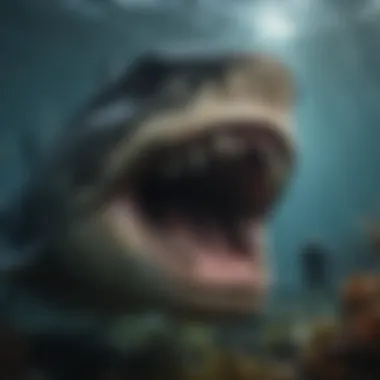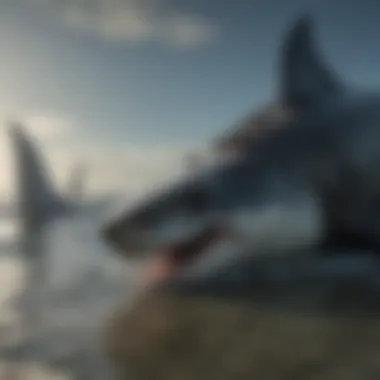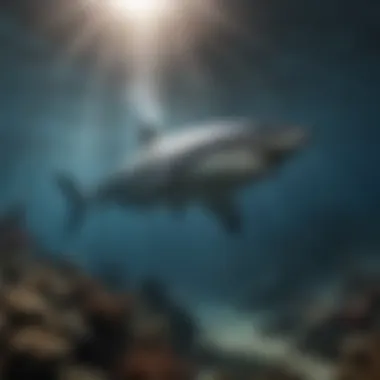Unraveling the Enigmatic Megalodon Habitats: A Comprehensive Exploration


Rock and Fossil Identification
Understanding the complexities of rock and fossil identification plays a crucial role in unraveling the mystery of megalodon habitats. As enthusiasts delve into this field, it is essential to grasp the different types of rocks and fossils that provide insights into ancient ecosystems. By recognizing distinct characteristics indicative of specific geological eras, researchers can piece together the puzzle of the megalodon's environment. Utilizing tools for identification such as magnifying glasses, rock hammers, and field guides further enhances the exploration process and sharpens the eye for unique specimens, fostering a deeper connection with the prehistoric world.
Collecting Tips and Techniques
Embarking on the journey to uncover megalodon habitats requires not only passion but also a mastery of collecting tips and techniques. Enthusiasts are encouraged to follow best practices when collecting rocks and fossils, ensuring the preservation of delicate specimens and adhering to ethical standards. Locating prime collecting sites calls for meticulous research and collaboration with fellow collectors, exchanging valuable information to increase the chances of striking paleontological treasures. Safely extracting specimens from their natural habitats demands precision and care to avoid damage, allowing for detailed examination and documentation of findings.
Preservation and Display
Once unearthed, the preservation and display of rocks and fossils are pivotal in conserving these remnants of prehistoric life for future generations. Employing techniques such as stabilizing fragile structures and using specialized coatings aids in maintaining the integrity of specimens over time. Proper storage methods involve climate control and avoiding exposure to direct sunlight to prevent deterioration. For enthusiasts looking to showcase their collections, creative display ideas ranging from shadow boxes to custom shelving systems offer unique ways to exhibit the beauty and scientific significance of fossil discoveries.
Geological Insights
Delving deeper into the geological insights offered by rocks and fossils provides a fascinating glimpse into the history of the Earth and the creatures that once roamed its landscapes. By studying geological formations and processes imprinted in rocks, researchers can reconstruct past environments and understand the conditions that shaped the megalodon's habitat. The historical significance of rocks and fossils extends beyond scientific curiosity, with each discovery offering a window into ancient ecosystems and evolutionary pathways. Notable discoveries in the field continue to enrich our understanding of the natural world, underscoring the importance of continued exploration and research in paleontology.
Introduction to the Megalodon
The "Introduction to the Megalodon" section serves as a crucial foundation for unraveling the mysteries surrounding this colossal prehistoric predator. By in-depth exploration in this section, readers are primed to delve deep into the riveting world of the Megalodon. Understanding the historical significance of this creature and its impact on ancient ecosystems is paramount in comprehending its habitat preferences and behavior patterns. This preliminary section sets the stage for a comprehensive analysis of the Megalodon and its habitats.
Overview of the Megalodon
Brief History of the Megalodon
Exploring the "Brief History of the Megalodon" unveils intriguing chapters of the Megalodon's existence through the ages. From its emergence millions of years ago to its eventual disappearance, studying this history provides invaluable insights into the evolution of this formidable predator. By delving into fossil records and historical accounts, researchers can piece together a timeline of the Megalodon's reign, shedding light on its ecological role and interactions within ancient marine ecosystems.
Physical Characteristics
Analyzing the "Physical Characteristics" of the Megalodon offers a glimpse into the anatomical marvels of this giant shark. By dissecting traits such as size, jaw structure, and teeth morphology, scientists can reconstruct a vivid image of this apex predator. Understanding how these physical attributes influenced the Megalodon's hunting strategies and predatory behavior is key to decoding its habitat preferences and ecological niche. With a focus on anatomical adaptations, this section unveils the evolutionary wonders of the Megalodon.
Significance of Studying Megalodon Habitats
Ecological Insights
Investigating "Ecological Insights" provides a panoramic view of the Megalodon's role within ancient marine food webs. By unraveling its position as a top predator and analyzing its interactions with prey species, researchers can glean valuable ecological knowledge. Understanding the Megalodon's impact on ecosystem dynamics offers crucial insights into maintaining ecological balance and preserving biodiversity in modern-day oceans.


Paleoenvironmental Research
Delving into "Paleoenvironmental Research" uncovers the environmental conditions that shaped Megalodon habitats. By examining factors such as sea temperature, ocean currents, and prey availability, scientists can reconstruct ancient marine ecosystems. This research not only illuminates the habitats preferred by the Megalodon but also provides a window into the broader environmental changes that may have influenced its evolution and extinction.
Paleogeography and Habitats
Paleogeography and Habitats play a crucial role in understanding the habitats of the Megalodon in this enlightening article. By delving into ancient oceanic environments, we unravel the mysteries of where this majestic creature once thrived.
Ancient Oceanic Environments
Tectonic Settings
Tectonic Settings form a fundamental aspect of our exploration into the Megalodon's world. These settings provide us with insights into the geological structures that shaped the Megalodon's habitat. A key characteristic of Tectonic Settings lies in their influence on oceanic currents and seafloor topography. The unique feature of Tectonic Settings is the way they dictated the distribution of prey species, impacting the Megalodon's predatory behaviors. While Tectonic Settings offer valuable information, their complexities can sometimes hinder our complete understanding of ancient oceanic ecosystems.
Temperature and Climate
Temperature and Climate are pivotal factors in deciphering the ancient environments of the Megalodon. These elements contribute significantly to shaping the distribution of marine life and the conditions in which the Megalodon thrived. The key characteristic of Temperature and Climate lies in their influence on ocean temperatures and overall ecosystem stability. The unique feature of Temperature and Climate is their role in driving species migrations and influencing prey abundance. While essential for our studies, variations in Temperature and Climate over geological timescales can present challenges in reconstructing past environments accurately.
Paleoecology of the Megalodon
Prey Availability
Prey Availability stands as a cornerstone in understanding the paleoecology of the Megalodon. This aspect sheds light on the abundance and diversity of prey species that sustained the Megalodon's immense size and predatory nature. The key characteristic of Prey Availability lies in its direct link to the Megalodon's foraging behaviors and population dynamics. The unique feature of Prey Availability is its role in shaping marine food webs and predator-prey relationships, influencing the evolution of the Megalodon. While invaluable for our understanding, fluctuations in Prey Availability due to environmental shifts can impact the Megalodon's survival strategies.
Competition with Other Species
The dynamics of Competition with Other Species offer us insights into the Megalodon's place in ancient ecosystems. Understanding these interactions provides a deeper comprehension of the Megalodon's role as a top predator and its adaptations for survival. The key characteristic of Competition with Other Species lies in its influence on resource competition and species coexistence within ancient marine communities. The unique feature of Competition with Other Species is its impact on the Megalodon's evolution, territorial behaviors, and ecological niche occupation. While essential for our research, deciphering these interactions can be challenging due to limited fossil evidence and the complexity of ancient food webs.
Megalodon Distribution
The Megalodon Distribution section of this article serves as a pivotal exploration of the habitats that once accommodated this immense prehistoric shark. To comprehend the ecosystem in which the Megalodon thrived is to unveil a world of fascinating ecological interactions and vital scientific insights. By delving into the distribution patterns of the Megalodon, we can piece together a narrative of the ancient oceans and the diverse regions that shaped the life of this formidable predator.
Global Distribution Patterns
Fossil Records Analysis


Diving into the realm of Fossil Records Analysis within the context of the Megalodon Distribution provides invaluable clues about the life and times of this enigmatic creature. Through meticulous examination of fossil remains, scientists can reconstruct the past environments where the Megalodon roamed, shedding light on its behaviors, interactions, and adaptations. The beauty of Fossil Records Analysis lies in its ability to transcend time, allowing us to peer into the ancient seas and unravel the mysteries of this majestic shark.
Biogeographic Concepts
Exploring Biogeographic Concepts within the Megalodon Distribution discourse unveils the interconnectedness of geographical factors and biological phenomena. By studying how the Megalodon's range correlated with various biogeographic realms, researchers can discern patterns that elucidate the shark's evolutionary history and distribution dynamics. Biogeographic Concepts offer a holistic perspective, bridging the gap between the physical environment and the living organisms that inhabited it, enriching our understanding of the Megalodon's global presence.
Hotspots of Megalodon Activity
Rich Fossil Deposits
Delving into the significance of Rich Fossil Deposits sheds light on the areas where an abundance of Megalodon remains have been unearthed. These fossil-rich locations serve as veritable treasure troves of information, providing researchers with vital data on population densities, feeding patterns, and ecological relationships within Megalodon communities. Rich Fossil Deposits offer a glimpse into the past, allowing us to piece together the puzzle of Megalodon distribution with remarkable clarity.
Oceanographic Factors
Examining the influence of Oceanographic Factors on Megalodon activity offers a nuanced understanding of how the shark's behaviors were intricately intertwined with the marine environment. From temperature gradients to ocean currents, these factors played a critical role in shaping Megalodon habitats and migration patterns. By unravelling the complexities of Oceanographic Factors, we can appreciate the delicate balance that governed the Megalodon's existence in a world profoundly different from our own.
Behavioral Adaptations
In this enthralling venture into the habitat of the megalodon, understanding its Behavioral Adaptations takes precedence. These adaptations were crucial for the megalodon's survival and dominance in its ecosystem. By delving into the nuances of its behavioral patterns, we unravel the intricate strategies that propelled this massive prehistoric shark to the apex of the food chain. Examining their Behavioral Adaptations sheds light on how they hunted, interacted with their environment, and navigated the challenges of their time. Through meticulous analysis, we decipher the evolutionary advantages and adaptations that made the megalodon a formidable predator. This in-depth exploration into their Behavioral Adaptations offers a profound insight into the complex world of this ancient sea creature.
Hunting Strategies
Predatory Behavior
The Predatory Behavior of the megalodon was a defining aspect of its survival and success. Their strategic approach to hunting and consuming prey showcases the apex predator's unparalleled efficiency in marine ecosystems. The instinctual hunting prowess of the megalodon, combined with its physical attributes, made it a dominant force in ancient seas. Understanding the nuances of their Predatory Behavior provides crucial insights into their feeding habits, hunting techniques, and ecological impact. Analyzing the key characteristics of the megalodon's Predatory Behavior reveals a sophisticated and adaptive predator finely tuned for survival in its habitat. This section delves into the unique features of their Predatory Behavior and evaluates the advantages it conferred in their evolutionary journey.
Social Interactions
The aspect of Social Interactions among megalodons offers a fascinating glimpse into their behavior beyond solitary hunting. These interactions played a pivotal role in shaping their group dynamics, communication methods, and reproductive strategies. By closely examining their Social Interactions, we uncover the complexities of their social structure and the significance of collaborative behaviors. Highlighting the key characteristics of megalodon Social Interactions elucidates how these giants navigated the challenges of cohabiting oceans and securing resources. Exploring the unique aspects of their Social Interactions sheds light on the advantages and disadvantages of social behavior within the context of megalodon survivability and evolution. Unraveling the intricacies of their social interactions contributes to a comprehensive understanding of the behavioral adaptations that were integral to their existence.
Reproduction and Migration
Breeding Grounds
The megalodon's choice of Breeding Grounds played a critical role in their reproductive success and population dynamics. Investigating the specific aspects of these areas provides insights into their mating rituals, gestation periods, and offspring care. By delving into their preferred Breeding Grounds, we uncover the significance of environmental factors in shaping the megalodon's reproduction strategies. Highlighting the key characteristics of Breeding Grounds offers a deeper understanding of how these locations influenced the species' long-term survival. Exploring the unique features of their selected Breeding Grounds allows us to assess the advantages and disadvantages of their reproductive choices within the context of prehistoric marine ecosystems.


Seasonal Movements
Examining the Seasonal Movements of the megalodon reveals a layer of complexity in their behavior and adaptability to changing environmental conditions. Their migration patterns, influenced by factors such as temperature, prey availability, and ocean currents, showcase the dynamic nature of these ancient giants. By scrutinizing the key characteristics of Seasonal Movements, we gain valuable insights into how megalodons navigated vast ocean expanses in search of optimal habitats and feeding grounds. Understanding the unique features of their Seasonal Movements offers a glimpse into the advantages and challenges they faced during their seasonal transitions. Evaluating the impact of seasonal migrations on their survival strategies provides a holistic view of the reproductive and ecological significance of these movements. This section peels back the layers of megalodon behavior, revealing how their seasonal movements were intricately linked to their evolutionary success.
Megalodon Extinction Theories
The section on Megalodon Extinction Theories delves into crucial explanations regarding the disappearance of this colossal marine predator. By scrutinizing the potential reasons behind the extinction of the megalodon, we unravel compelling insights into the evolutionary dynamics of prehistoric oceans and marine life. Providing a comprehensive review of Megalodon Extinction Theories showcases the interdisciplinary nature of paleontological research, correlating environmental shifts with biological adaptations.
Environmental Changes
Impact of Climate Shifts
Exploring the Impact of Climate Shifts is paramount in understanding the overarching narrative of the megalodon's demise. Shifts in climate patterns potentially influenced the distribution of marine species, subsequently impacting the evolutionary trajectory of the megalodon population. Investigating the repercussions of these climate shifts on megafauna illuminates the interconnectedness of environmental dynamics and biological responses. This detailed analysis contributes significantly to our comprehension of the complex ecosystems in which the megalodon thrived.
Biological Factors
Delving into Biological Factors provides an in-depth examination of how intrinsic biological characteristics may have influenced the fate of the megalodon. Factors such as reproductive strategies, genetic diversity, and physiological adaptations play pivotal roles in the survival or extinction of species. Understanding the interplay between biological attributes and environmental variables enhances our ability to construct detailed extinction scenarios. The exploration of Biological Factors enriches the narrative of megalodon extinction theories, offering a nuanced perspective on the multifaceted forces at play.
Competitive Pressures
Rival Species
Examining the influence of Rival Species sheds light on the competitive landscape faced by the megalodon in ancient oceans. Competing for resources, territory, and breeding grounds with other apex predators shaped the evolutionary trajectory of the megalodon species. Analyzing interactions with contemporary marine species deepens our understanding of interspecies dynamics and ecological shifts. By dissecting the impact of rival species on the megalodon's survival, we unravel a critical aspect of its extinction narrative.
Food Source Depletion
Exploring the ramifications of Food Source Depletion addresses the crucial role of food availability in the decline of the megalodon population. Depletion of primary prey species or changes in trophic dynamics could have strained the megalodon's ability to sustain its large size and energy requirements. Investigating the effects of dwindling food sources on apex predators like the megalodon uncovers intricate ecological cascades that may have contributed to its extinction. This section provides key insights into the interconnectedness of marine food webs and apex predator survival.
Conclusion
The article culminates in presenting the legacy of the megalodon, encapsulating its significance and impact on various realms. Understanding the context in which this massive prehistoric shark thrived provides invaluable insights into the evolution of marine ecosystems. By scrutinizing the past habitats of the megalodon, researchers can unveil critical information that illuminates broader aspects of paleoecology. Delving deep into the habitats of this ancient predator not only unlocks scientific mysteries but also serves as a gateway to comprehending the interconnectedness of species and environments through time. The ultimate takeaway from this exploration lies in recognizing the megalodon as a pivotal figure in the paleoenvironmental narrative, making its habitats a crucial piece in reconstructing the puzzle of Earth's evolutionary history.
Legacy of the Megalodon
Scientific Discoveries
Exploring the scientific endeavors surrounding the megalodon unravels a tapestry of groundbreaking discoveries. Studying the fossil records of this colossal shark has not only expanded our knowledge of prehistoric marine life but has also offered unparalleled insights into the evolution of oceanic ecosystems. Scientists have meticulously dissected each skeletal remains to glean information about the megalodon's anatomy, behavior, and ecological role. Moreover, these discoveries have paved the way for innovative research methodologies, pushing the boundaries of paleontological studies. The meticulous analysis of megalodon fossils continues to yield invaluable data, shaping our understanding of ancient marine habitats and predator-prey dynamics. Despite the challenges presented by fragmented remains, the scientific community's persistent efforts have pieced together a remarkable mosaic of information that showcases the megalodon's dominance in its primeval realm.
Popular Culture Impact
The enthralling allure of the megalodon has transcended scientific realms, manifesting in popular culture through various mediums. Its colossal size and formidable presence have captivated the imaginations of enthusiasts worldwide, spawning a wave of cinematic adaptations and literary works. The iconic image of this prehistoric predator has left a lasting imprint on mainstream media, fueling public fascination with megafauna and ancient marine creatures. The popular culture impact of the megalodon extends beyond entertainment, sparking dialogues about conservation, evolution, and the mysteries of the deep sea. Through movies, documentaries, and artistic representations, the megalodon has become a symbol of primal power and enigmatic allure, contributing to a broader cultural conversation about our planet's history and the enigmatic creatures that once roamed its waters.







